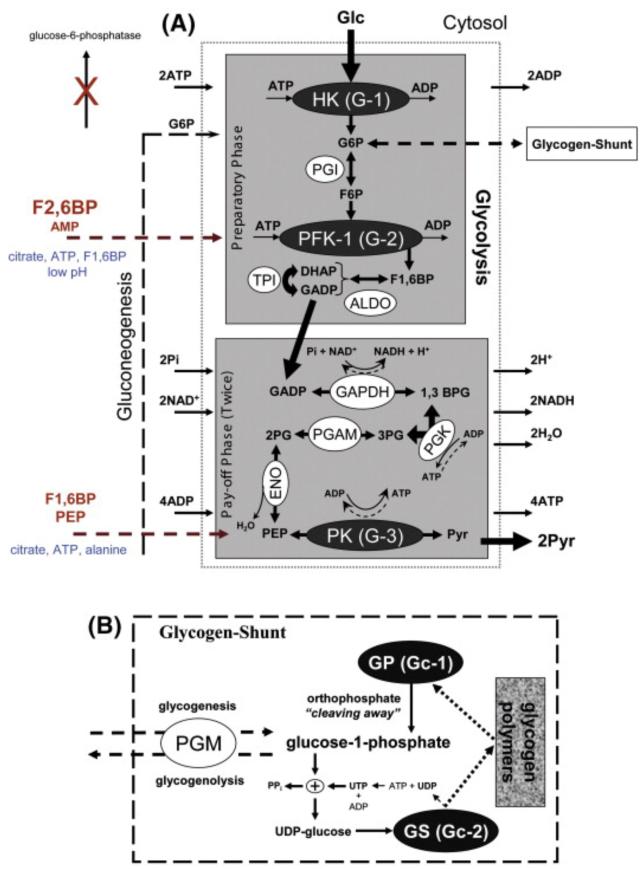Fig. 1.
A) Diagram of the preparatory and pay-off phases in glycolysis. The preparatory phase comprises four steps: a first phosphorylation [enzyme (HK), substrates (Glc, ATP), products (G6P, ADP), comments (a-it is the control point G-1, b-HK isozymes have direct access to mitochondrial ATP through specific binding to porins)], an isomerase reaction [enzyme (PGI), substrate (G6P), product (F6P), comment (it is a reversible and not normally favorable reaction driven by the concentration of F6P)], a second phosphorylation [enzyme (PFK-1), substrates (F6P, ATP), products (F1,6BP, ADP), comments (a-it is the control point G-2, the most important in glycolysis, b-during gluconeogenesis, a pathway crucial in developing brain, the reverse conversion must be performed by fructose 1,6 bisphosphatase)], an aldol reaction [enzyme (ALDO), substrate (F1,6BP), products (DHAP, GADP), comment (DHAP and GADP are rapidly and reversibly interconverted by TPI, a step essential to produce energy efficiently)]. The pay-off phase comprises five steps: a redox reaction [enzyme (GAPDH), substrates (GADP, NAD+, Pi), products (1,3BPG, NADH, H+), comment (the highly exergonic oxidation of GADP drives the endergonic transferring of Pi to an intermediate to finally form 1,3BPG, a product with high phosphoryl-transfer potential)], a first substrate-level phosphorylation [enzyme (PGK), substrates (1,3BPG, ADP), products (3PG, ATP), comment (it is the break-even point in glycolysis)], a mutase reaction [enzyme (PGAM), substrate (3PG), product (2PG), comment (a mutase does not change the oxidation state of the carbons in the compound)], a hydration [enzyme (ENO), substrates (2PG), product (PEP, H2O), comment (there are several enolase isozymes in humans)], a second substrate-level phosphorylation [enzyme (PK), substrates (PEP, ADP), products (Pyr, ATP), comment (it is the control point G-3)]. The negative and positive allosteric effectors are highlighted in blue and orange, respectively. B) The glycogen shunt hypothesis. Glycogenesis: The PGM, an isomerase, synthezises glucose-1-phosphate from G6P. The enzyme GS is responsible for the synthesis of glycogen polymers. This pathway utilizes UDP-glucose as the activated Glc donor. Glycogenolysis: Phosphorolysis by enzyme GP is the cleaving away of a bond by orthophosphate, and thus degradation of glycogen polymers to glucose-1-phosphate; which can then be isomerized to G6P by PGM iso-energetically. Abbreviations: ALDO → fructose 1,6 bisphosphate aldolase, DHAP → dihydroxyacetone phosphate, TPI → triose-phosphate isomerase, GAPDH → glyceraldehyde phosphate dehydrogenase, NAD+ → nicotinamide adenine dinucleotide (oxidized form), 1,3BPG → 1,3-bisphosphoglycerate, 3PG → 3-phosphoglycerate, 2PG → 2-phosphoglycerate, PGAM → phosphoglycerate mutase, ENO → enolase.

